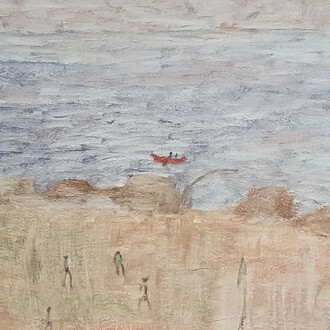H. C. Westermann’s work combines a graceful mastery of materials, rough and tumble physicality, commonsense philosophizing, acrobatic wit and wordplay, and a sensitive worldview shaped in equal measure by the horrors of wartime and the devotions of love. He used a wide-range of materials but was most dedicated to woodworking, once stating that wood was his “whole life.”
Westermann attended the School of the Art Institute of Chicago twice, once after his service in World War II and again after his service in the Korean War. His depth of experience, humble work ethic, and dedication to craft influenced a generation of artists across Chicago, Los Angeles, and beyond.
In the Pacific theater of World War II, Westermann served on the USS Enterprise and witnessed violence that shaped his existential worldview and inflected his artworks. Given his time at sea, he often used the symbol of an anchor—alone or in conjunction with his name or initials—as his signature.
His work is characteristic of a time before the art historical labels of the 1960s had calcified into hardened categories, and he exhibited in various important exhibitions dedicated to Existential Figuration, Assemblage, and Surrealism. While fellow artist Donald Judd identified him as a key maker of "Specific Objects" in 1963, Westermann’s openness to mass culture has often grouped him with contemporaneous Pop Art, and in 1972 he was included alongside major international Conceptual artists in the exhibition Documenta V. Westermann’s ability to traverse so many historical contexts is a testament to the independence of this consummate American artist.
H. C. Westermann: Anchor clanker is the largest gathering of sculptures by the artist in Chicago in over 20 years presented on the occasion of a generous and transformative gift of 17 Westermann sculptures from the Estate of Alan and Dorothy Press.
















